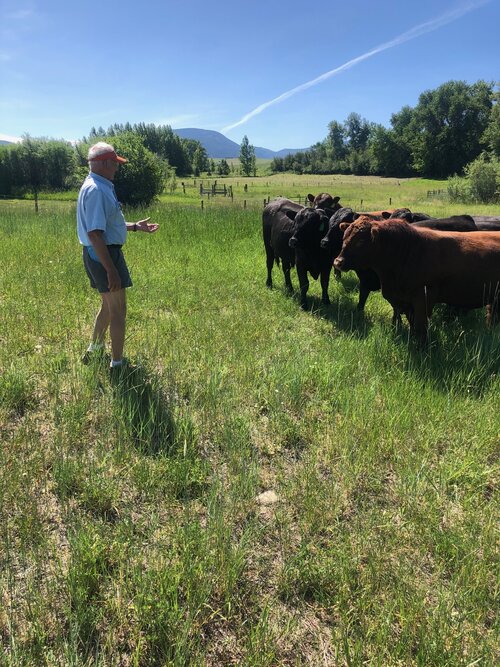Ranching with, but not for Money: Enjoying Liberty, Ecology and Prosperity
By: John A. Baden, Ph.D.Posted on April 05, 2021 FREE Insight
Ranching with, but not for Money: Enjoying Liberty, Ecology and Prosperity
Here are some thoughts for another fine spring day. I made them while living on a ranch in Montana, the most remote of Americas’ lower 48 states. The cost of distance, once a huge liability to those living here, has dropped immensely. Here’s how.
The Internet instantly connects everywhere while FedEx and UPS have overnight delivery. Another marker: The Bozeman airport has experienced continuous and strong growth. In 2019, traffic reached the highest in Bozeman history at 788,152 passengers. We now have over twenty direct flights to America’s major cities.
Meanwhile, burdens of big city congestion, disruption, corruption continue to increase. On February 10 of 2021 NPR reported: In Minneapolis there were 405 car-jackings last year — more than triple the number in 2019….” This was recently revised; a Minneapolis police report that carjacking there have shot up 537% this year.
In marked contrast, life here is ever better. While big city life becomes less attractive and more people escaping, we are on a large, comfortable, and well-provisioned homestead surrounded by rangelands and mountains. (Check out the ranch website for beautiful photos here. Baden-BadenRanch.com)

Although in spring mornings we may awaken to what Ramona calls " lamb killing snows" (heavy, wet, and wind driven), it's a delight to live here. The mountains are building up a heavy snowpack, great for Ramona's skiing at Big Sky and Bridger Bowl. This summer we'll enjoy easy irrigation and cold trout waters.
More immediately, we are well prepared. For example, should show conditions get really tough as was common a few decades ago, our "new" International Harvester plow trick, actually a low milage 1980 2 & 1/2 ton 4x4 with a newer 444 cubic inch tricked-out diesel, can deliver hay to the Hyline Angus Ranch cows calving on our winter range. Modern technology conjoined with modest prosperity makes for easier and more secure and comfortable rural living.
Related to this theme, I'm working on my Liberty, Ecology and Liberty project with a professional editor and friend who lives in Grand Rapids, Michigan. (The cost of distance continues to drop, especially with good Internet connections.) This book project includes hosting a panel with the Liberty, Ecology and Liberty theme for the FreedomFest conference in Rapid City in late July. Traditionally held in Las Vegas, due to COVID this year it's moved -- and I'm delighted to return to South Dakota.
In the late ‘60s I spent lots of good times in South Dakota while interviewing Hutterites for my economic anthropology thesis. I often stayed in an old bunkhouse on Tedd and Gertrude Mann's ranch between Custer, South Dakota, and Newcastle, Wyoming. I enjoyed working with Tedd and earning my keep by moving cattle and building fence on Dave True's 70,000 acre ranch. I didn't then know Mr. True but decades later I served with him on the National Petroleum Council (NPC). I was one of three academics on the NPC while Dave, CEO of True Drilling in Casper, WY, was one of some 90 oilmen .
That bunkhouse experience convinced me that to be fulfilled as an adult, I too would need a real ranch, not a 10, 20 or 40 acre "ranchette." Luckily, I first saw ours in 1968. Just after signing on to teach at Montana State University, I bought it in 1970, mostly with borrowed money. How could a newly minted Ph.D. with a professor’s salary possibly borrow such money?
Easily, for in 1970 revenue from irrigated ranchland in the Gallatin Valley would nearly cover mortgage payments. How was this possible? In 1968, some ranch land within 15 miles of Bozeman sold for under $200 an acre. Today, if you were lucky enough to find any, even ag land without development potential, would sell for $10,000 to $20,000 per acre. Ours would be at the high end even though 90 % of our land is in a conservation easement with the Gallatin Valley Land Trust.
Today it's not possible to buy Gallatin Valley land and come close to paying for it with revenue from agricultural production. In 1970 steers sold for $30 per hundred weight. Correcting for inflation, that's $200 in today's prices. However, today steers sell for $160 per hundredweight. Steer prices have dropped by 20% since 1970. Dave Johnson, a partner with Hall and Hall Ranch Brokers (America’s largest), tells me the cost of choice Gallatin Valley land with good views and secure irrigation and livestock water have increased fifty to a hundred times.
What’s the lesson here? American are searching out places to live, work and raise families where they are free to build, save and prosper. A place like Bozeman, with its close proximity to Yellowstone National Park, and blue-ribbon trout streams, makes it especially attractive. But there are places throughout much of America where personal liberty, modest prosperity, natural beauty, and sustainable ecology can be found.
People seeking better, safer living need not despair. There still are many places in America where liberty, environmental quality and at least modest prosperity converge. However, here is fair warning; proximity to great attractions such as Yellowstone or Teton national parks, or towns resembling Bozeman, MT or Boulder, CO add a substantial premium.

